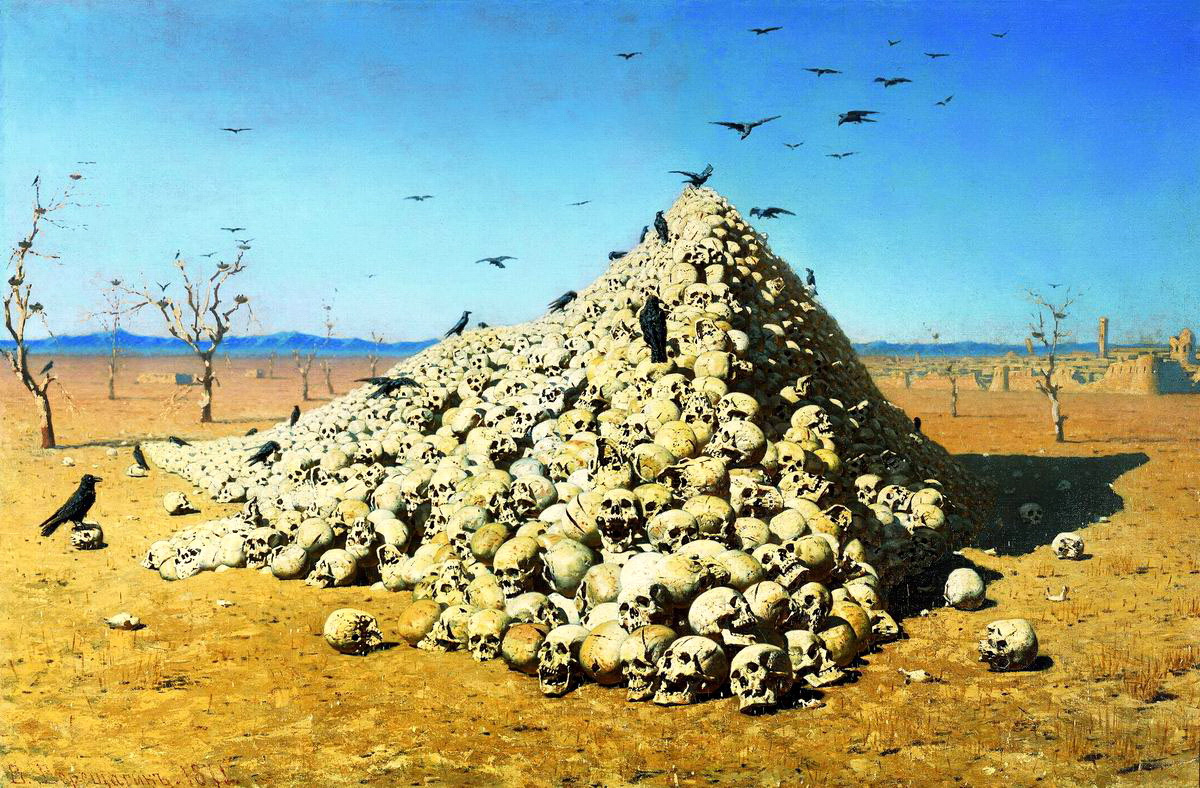log in
Enter site
Login to use Arthive functionality to the maximum
The apotheosis of war
Vasily Vereshchagin • Painting, 1871, 127×197 cm
Description of the artwork «The apotheosis of war»
"If you don't take into account the ravens, it is a still life, which translates into French as “nature morte"- Vereshchagin described the painting.
Today, "the Apotheosis of war" is the object of numerous imitations, parodies, and visual memes, without any temporal or geographical boundaries.
However, the efficacy of Vasily Vereshchagin as "judge of mankind" was already clear to his contemporaries. Being in the USA at the invitation of the art Institute of Chicago, the artist wrote out the letter: "To my proposal to let to the exhibition children at a low price I was told that my paintings can make youth to turn away from war, which was undesirable for the organizers". The first ever nominee for the Nobel peace prize, Vereshchagin could have hardly count on a better compliment.
Written by Andrew
While working on his most famous painting, Vasily Vereshchagin had a very specific historical context on his mind – he was going to call it "The Triumph of Tamerlane". However, when the work was finished, the artist realized that he had created a universal image, a powerful anti-war statement, which went beyond any historical era, person or a legend.
Prone to sarcasm, Vereshchagin often accompanied his paintings with dedications, titles or descriptions, which made the homesitting patriots nervous much stronger than the canvases . We can assume that the painting of the effects of the bloody storming of Plevna
would be greeted by the Royal family much more favorably, if the artist was not going to call it "Royal birthday". And the triptych depicting the freezing soldier would not have caused such a violent reaction, if not the title that Vereshchagin chose - All quiet on Shipka.
The Apotheosis of War was no exception: to avoid confusion, the artist made the inscription on the frame: "Dedicated to all great conquerors of the past, present and future".
"It's not only about the skills Vereshchagin employed in rendering the dry steppe and a pyramid of skulls with crows flying around in search of another piece of meat” – art critic Vladimir Stasov wrote about this painting, –“No! There is something more precious and higher than Vereshchagin’s extraordinary virtuality of colors, here is a deep sense of a historian and judge of the mankind."
As an artist and as a "judge of mankind", Vereshchagin always aspired to objectivity, he always tried to show both sides of the coin. If he painted a picture called "After good luck", he certainly balanced it with another canvas, which was titled "After the failure"; and if he painted "The winners" he necessarily found time for "The losers". Vereshchagin's "Apotheosis of war" stood out from most of his "military" paintings with the artist’s unshakable position. The hill of the skulls that were cut by the swords, the dead mouths gaping in a silent cry, the scavengers feasting in the middle of a barren desert – this is the essence of any war, its genuine character and the only result.
"If you don't take into account the ravens, it is a still life, which translates into French as “nature morte"- Vereshchagin described the painting.
Today, "The Apotheosis of war" is the object of numerous imitations, parodies, and visual memes, without any temporal or geographical boundaries. You can see its echoes in movies like "Terminator" or "Survivors".
However, the efficacy of Vasily Vereshchagin as "judge of mankind" was already clear to his contemporaries. Being in the USA at the invitation of the art Institute of Chicago, the artist wrote out the letter: "To my proposal to let to the exhibition children at a low price I was told that my paintings can make youth to turn away from war, which was undesirable for the organizers". The first ever nominee for the Nobel peace prize, Vereshchagin could have hardly count on a better compliment.
Written by Andrew Zimoglyadov




